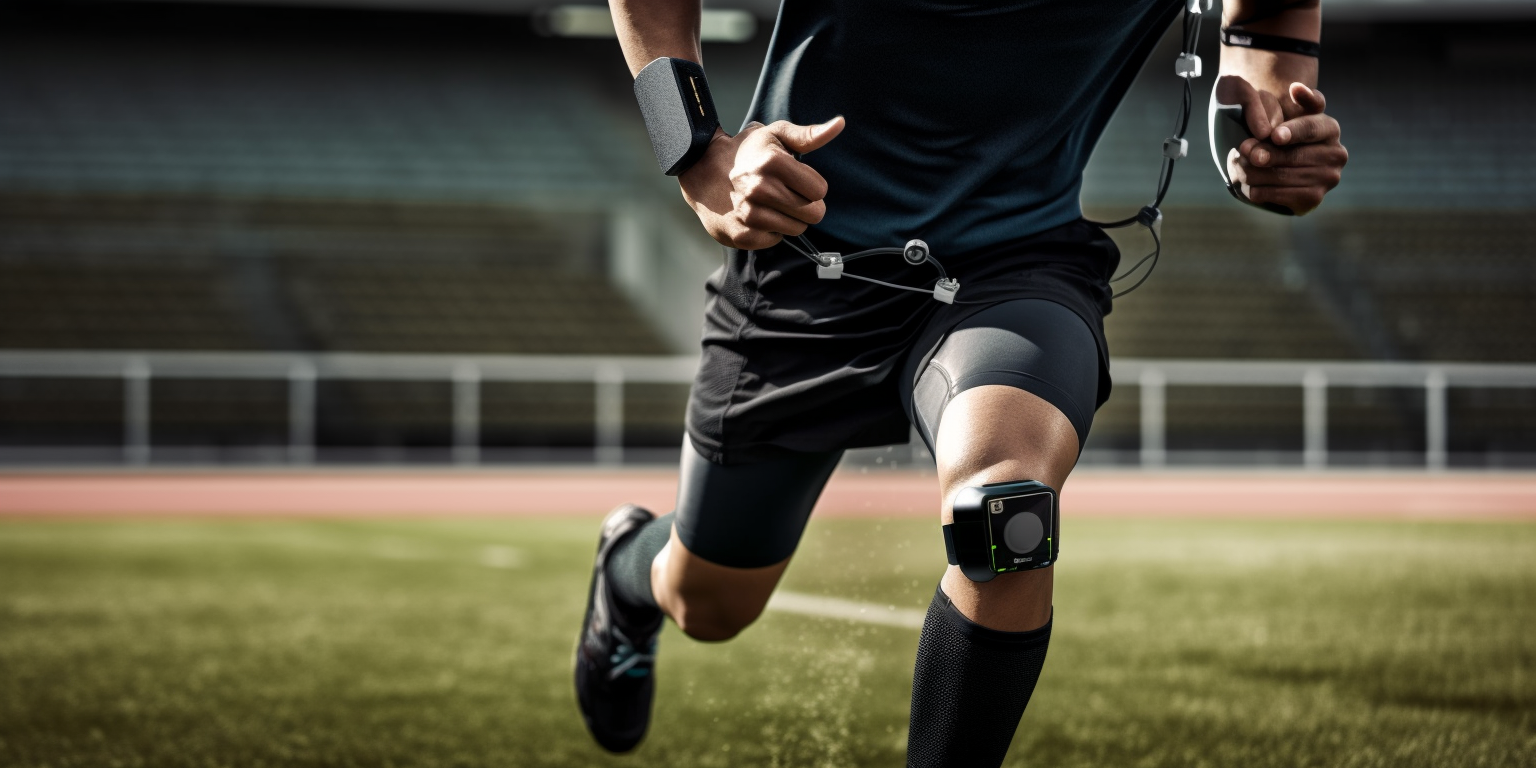Wearable technology has revolutionized the way athletes train and perform. With the advent of biometric tracking and performance monitoring, athletes can now track their progress and make data-driven decisions to improve their performance. Wearable technology has become an essential tool for athletes and coaches alike, providing valuable insights into an athlete’s physical and mental state.
Athletic training has always been a complex process, requiring a combination of physical and mental preparation. Wearable technology has made this process more efficient and effective by providing real-time data on an athlete’s performance. Biometric tracking devices such as heart rate monitors, GPS trackers, and accelerometers can provide valuable information on an athlete’s physical state, including their heart rate, speed, and distance covered.
Performance monitoring is another critical aspect of athletic training, and wearable technology has made this process more accessible than ever before. Wearable devices can track an athlete’s progress over time, providing valuable insights into their strengths and weaknesses. This information can be used to develop personalized training programs that target specific areas of improvement.
Data analytics is another critical aspect of wearable technology in sports. By analyzing the data collected by wearable devices, coaches and athletes can gain valuable insights into their performance. This information can be used to make data-driven decisions, such as adjusting training programs or making changes to an athlete’s diet.
In conclusion, wearable technology has revolutionized the way athletes train and perform. Biometric tracking, performance monitoring, and data analytics have become essential tools for athletes and coaches alike, providing valuable insights into an athlete’s physical and mental state. As wearable technology continues to evolve, we can expect to see even more innovative solutions that will help athletes reach their full potential.
Benefits of Wearable Tech
Wearable technology has revolutionized the way athletes train and perform. With the help of biometric tracking and performance monitoring, wearable tech has become an essential tool for athletes and coaches alike. The data analytics provided by wearable tech has helped athletes to improve their performance and reduce the risk of injury.
One of the most significant benefits of wearable technology in athletic training is the ability to track biometric data. Wearable devices can track heart rate, oxygen levels, and other vital signs, providing athletes with real-time feedback on their physical condition. This information can help athletes to adjust their training regimen to optimize their performance and avoid overexertion.
Performance monitoring is another key benefit of wearable technology. Wearable devices can track an athlete’s movements, including speed, acceleration, and deceleration. This information can help coaches to identify areas where an athlete needs improvement and develop a training plan to address those weaknesses.
Data analytics is perhaps the most significant benefit of wearable technology in sports. Wearable devices can collect vast amounts of data on an athlete’s performance, which can be analyzed to identify patterns and trends. This information can help coaches to develop more effective training plans and make better decisions about player selection and game strategy.
In conclusion, wearable technology has revolutionized athletic training and performance monitoring. The benefits of wearable tech include biometric tracking, performance monitoring, and data analytics. With the help of wearable technology, athletes can optimize their performance, reduce the risk of injury, and achieve their full potential.
Types of Wearable Devices
Wearable technology has revolutionized the way athletes train and perform. These devices have become increasingly popular in the world of sports due to their ability to track biometric data and monitor performance. The data collected by these devices can be analyzed to provide insights into an athlete’s strengths and weaknesses, allowing coaches to tailor training programs to maximize performance.
There are several types of wearable devices used in athletic training, including smartwatches, fitness trackers, and heart rate monitors. These devices are equipped with sensors that track various biometric data, such as heart rate, steps taken, and calories burned. They can also monitor sleep patterns, which is crucial for athletes who need to ensure they are getting enough rest to perform at their best.
One of the most significant benefits of wearable technology in sports is the ability to monitor an athlete’s performance in real-time. This allows coaches to make adjustments to training programs on the fly, ensuring that athletes are getting the most out of their workouts. Additionally, wearable devices can help prevent injuries by alerting coaches to potential issues before they become serious.
Data analytics is another critical aspect of wearable technology in sports. The data collected by these devices can be analyzed to provide insights into an athlete’s performance, allowing coaches to identify areas for improvement. This data can also be used to track progress over time, providing athletes with a sense of accomplishment and motivation to continue training.
In conclusion, wearable technology has revolutionized the way athletes train and perform. These devices provide coaches with valuable insights into an athlete’s performance, allowing them to tailor training programs to maximize results. With the continued development of wearable technology, we can expect to see even more advancements in athletic training and performance monitoring in the future.
Biometric Tracking and Performance Monitoring
Biometric tracking and performance monitoring have become essential tools for coaches and athletes to improve their performance and prevent injuries. Wearable technology has made it possible to collect data on various aspects of an athlete’s performance, including heart rate, speed, distance, and even sleep patterns.
Athletic training has become more data-driven, with coaches and trainers using biometric tracking to monitor an athlete’s progress and adjust their training accordingly. Wearable technology has made it possible to track an athlete’s performance in real-time, allowing coaches to make immediate adjustments to their training regimen. This has led to more efficient and effective training programs, resulting in better performance and fewer injuries.
Performance monitoring has also become more sophisticated with the use of wearable technology. Data analytics tools can now analyze large amounts of data collected from wearable devices to identify patterns and trends in an athlete’s performance. This information can be used to identify areas where an athlete needs to improve and to develop personalized training programs that address their specific needs.
Wearable technology has also made it possible to monitor an athlete’s recovery from injuries. Biometric tracking can be used to monitor an athlete’s progress as they recover from an injury, allowing coaches and trainers to adjust their training program accordingly. This can help athletes recover more quickly and reduce the risk of re-injury.
In conclusion, wearable technology has revolutionized athletic training and performance monitoring. Biometric tracking and performance monitoring have become essential tools for coaches and athletes to improve their performance and prevent injuries. With the use of data analytics tools, coaches and trainers can develop personalized training programs that address an athlete’s specific needs. Wearable technology has made it possible to monitor an athlete’s progress in real-time, allowing for immediate adjustments to their training regimen.
Data Analytics and Performance Optimization
With the help of biometric tracking and performance monitoring, athletes can now optimize their training and improve their performance. Wearable technology has become an essential tool for athletic training, providing real-time data analytics that help athletes and coaches make informed decisions.
Biometric tracking is one of the most significant benefits of wearable technology in sports. It allows athletes to monitor their heart rate, breathing rate, and other vital signs during training and competition. This data can be used to optimize training programs and improve performance. Biometric tracking also helps athletes avoid overtraining and injury by providing real-time feedback on their physical condition.
Performance monitoring is another critical aspect of wearable technology in sports. It allows athletes to track their progress and identify areas for improvement. Performance monitoring can also help coaches identify weaknesses in their athletes and develop training programs that address those weaknesses. With the help of wearable technology, athletes can now train smarter, not harder.
Data analytics is the final piece of the puzzle when it comes to wearable technology in sports. It allows coaches and athletes to analyze the data collected from biometric tracking and performance monitoring and make informed decisions about training and performance. Data analytics can help coaches identify trends and patterns in their athletes’ performance, which can be used to develop more effective training programs.
In conclusion, wearable technology has revolutionized athletic training and performance optimization. Biometric tracking, performance monitoring, and data analytics have become essential tools for athletes and coaches looking to improve their performance. With the help of wearable technology, athletes can now train smarter, not harder, and achieve their full potential.
Limitations
Wearable technology has revolutionized the way athletes train and perform. With the help of biometric tracking and performance monitoring, wearable devices have become an essential tool for athletes and coaches alike. These devices provide real-time data analytics that help athletes optimize their training and improve their performance.
One of the most significant advantages of wearable technology in athletic training is the ability to track biometric data. Wearable devices can monitor heart rate, oxygen levels, and other vital signs, providing athletes with valuable insights into their physical condition. This data can be used to adjust training programs and optimize performance.
Performance monitoring is another critical aspect of wearable technology in sports. Wearable devices can track an athlete’s movements, speed, and other performance metrics, providing coaches with valuable insights into their performance. This data can be used to identify areas for improvement and adjust training programs accordingly.
Data analytics is another critical feature of wearable technology in sports. Wearable devices can collect vast amounts of data, which can be analyzed to identify patterns and trends. This data can be used to optimize training programs, improve performance, and prevent injuries.
Despite the many advantages of wearable technology in sports, there are some limitations to its use. One of the most significant limitations is the cost of these devices. High-end wearable devices can be expensive, making them inaccessible to many athletes and teams.
Another limitation is the accuracy of the data collected by wearable devices. While these devices are becoming increasingly accurate, there is still room for improvement. Inaccurate data can lead to incorrect conclusions and suboptimal training programs.
In conclusion, wearable technology has revolutionized athletic training and performance monitoring. With the help of biometric tracking, performance monitoring, and data analytics, athletes and coaches can optimize training programs and improve performance. While there are some limitations to the use of wearable technology in sports, the benefits far outweigh the drawbacks.
Wearable technology has revolutionized the way athletes train and perform. Biometric tracking and performance monitoring have become essential tools for coaches and athletes alike. Wearable technology has made it possible to collect data on an athlete’s performance in real-time, allowing coaches to make informed decisions about training and strategy.
Athletic training has become more efficient and effective with the use of wearable technology. Biometric tracking devices can monitor an athlete’s heart rate, oxygen levels, and other vital signs, providing coaches with valuable information about an athlete’s physical condition. Performance monitoring devices can track an athlete’s movements and provide feedback on technique, helping athletes to improve their form and reduce the risk of injury.
Data analytics has become an integral part of athletic training, and wearable technology has made it possible to collect and analyze vast amounts of data. Coaches can use this data to identify areas where athletes need to improve and develop personalized training programs to help them reach their full potential. Data analytics can also help coaches to identify trends and patterns in an athlete’s performance, allowing them to make informed decisions about training and strategy.
In conclusion, wearable technology has revolutionized athletic training and performance monitoring. Biometric tracking and performance monitoring devices have become essential tools for coaches and athletes, providing valuable information about an athlete’s physical condition and performance. Data analytics has become an integral part of athletic training, allowing coaches to make informed decisions about training and strategy. With the continued development of wearable technology, the future of athletic training looks bright.






